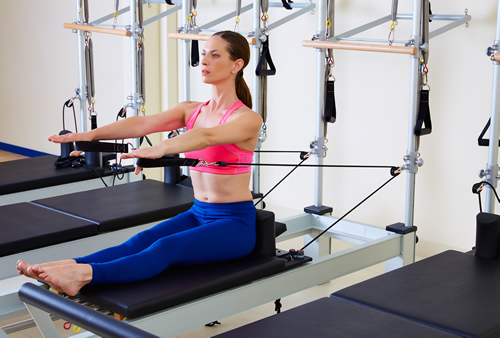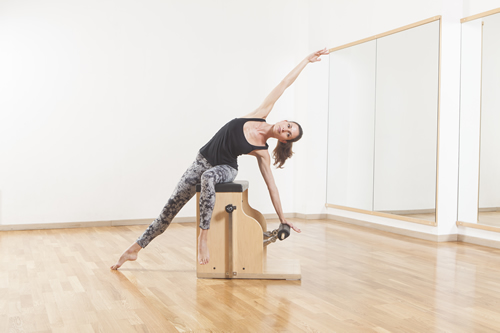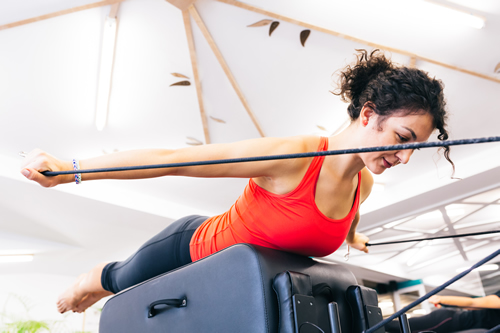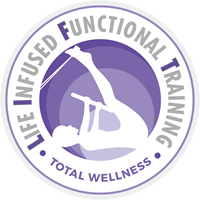Pilates
People who practice Pilates, even as infrequently as once a week, and concentrate for a 50 minute session while “giving it their all,” see more improvements than those who practice more regularly but don’t make the effort when they are working out.



Sessions are $65 solo | $35 pp duet | $30 pp trio | $25 pp 4 plus
Terisha’s Pilates instruction provides exercises to increase core strength, tone and strengthen the abdominal muscles and sculpt long, lean muscles, correcting posture and diminishing pain. Terisha shows proper stretching techniques to increase flexibility and offers detailed Pilates technique instruction and homework, so you can learn how to do Pilates properly to get the most results in her class and on your own.
The exercise equipment used in Pilates provides support for the body, so that individuals of all ages and fitness levels, even those undergoing physical therapy, can discover exercises to challenge their strengths and strengthen their weaknesses.
How can I benefit from Pilates?
By coordinating the movement with the breath, Pilates can be relaxing and invigorating, all at the same time!
As you become more aware of alignment and posture and you strengthen your abdominal muscles from the inside out, you will be protecting your lower back from day to day pressures and “microtrauma.” In other words, the smaller stresses due to faulty alignment that can cause big problems over time.
.
Is Pilates for everyone?
The Reformer is one of the most important pieces of equipment in Pilates. Using the Reformer challenges the user’s strength and flexibility. The Reformer challenges the body to work in concert, rather than working on individual, very specific parts of the anatomy (as is the case with the Cadillac,) the Reformer works on the body as a whole.
Clients who regularly take Pilates private and group training often notice that they look taller and feel much more comfortable in their own skin.
Regular exercise is important for everyone, but it may be especially critical for seniors. Have you ever noticed that the gap between those who don’t exercise and those who do exercise seems to widen over time? Men and women who work out consistently through their 50s, 60s, 70s and even 80s and 90s look amazing, while their counterparts who don’t exercise can look withered or weak. All the symptoms of a sedentary life, like poor muscle tone, bad posture, hunched shoulders, lower back pain, excess weight, and “spare tires,” worsen significantly in older age. The invisible effects of a life without exercise also increase. Senior citizens who don’t work out regularly are often plagued with aches and pains, poor sleep, bad circulation, stiff necks, loss of bone density, and a lack of energy.
The good news is that exercise can dramatically reverse these ills. Pilates is very safe for seniors to perform, making it a great exercise choice. Once you begin taking your Pilates workouts, you’ll notice some wonderful sensations almost immediately. The first signs that Pilates is working for you will be an increase in energy and a lessening of pain.
How is Pilates different from Yoga?
Depending on which method of yoga you practice, yoga tends to focus more on meditation than Pilates does.
Terisha believes yoga and Pilates are very complementary! Terisha encourages you to experience the benefits of both and discover what combination of the two is best for your body.
How often should I do Pilates?
If you have been doing Pilates a while, you can do it as often as you like! Just listen to your body and respond to its needs. If it feels good and you are looking forward to it, DO IT! If your back or neck is bothering you because of work, stress, tension and you are dreading it, then by all means, give yourself a break! You’ll enjoy your next Pilates workout so much more!
To see the results you desire, consistency is the key! The workouts created for you come in lengths of 50 minutes with “homework exercises” as short as 10 minutes – so it is easy to “sneak in a workout!”
How long before I see results?
Please remember: you get out of your workouts what you put into them! People who practice Pilates, even as infrequently as once a week, and concentrate for the full hour and “give it their all,” see more improvements than those who practice more regularly but don’t make the effort when they are working out.
What is the difference between mat Pilates and equipment Pilates?
Equipment Pilates consists of over 500 exercises using a Reformer and Tower alone. The equipment provides the support necessary to strengthen the abdominal muscles and low back without the risk of injury to the lumbar spine (lower back.)
Equipment work allows for more work on the arms, legs, shoulder and hip joints than does mat work. Again, all equipment work is supported, so you are never jeopardizing the safety of your lower back.
Mat work is an excellent workout and an excellent builder of core strength when done correctly.
Terisha blends traditional mat exercises into her classes, homework assignments and, for customized variations, to use when watching a video at home.
.
I feel a lot of the abdominal exercises in my neck. What should I do?
Thus, until the pain subsides, avoid doing exercises which tend to cause the neck pain to flare. This might mean avoiding exercises in which you start supine (lying flat on your back) and curl the head and shoulders off the mat, and/or avoiding exercises which start prone (on your stomach.)
As weak abdominals may be the cause of the neck tension, working on strengthening the abdominal muscles is always good. Choosing exercises that start seated on the “sits” bones and roll back from there are more “neck-friendly” than others. In addition, exercises in the all-fours position can really help you connect with your deepest abdominal muscle, the transversus abdominis, and this will help your abdominal muscle endurance as well.
Classical Mat Pilates involves neck flexion! So if you’re taking a traditional Mat exercise class and your neck hurts, (perhaps stenosis, an old injury, degenerative disc, etc) you probably need Terisha to work with you to find variations of Mat exercises that are good for YOUR body. It’s true as most clients’ abdominal muscles increase in strength, they’ll be able to curl up higher off the mat so that the head will be more supported on top of the shoulders. However, having the head propped up or even completely down on the mat during “the hundred” for example, is still a great exercise. There are so many great exercises in Pilates that at Lift Total Wellness, if an exercise just isn’t right for you then we move on to the hundreds left to choose from.
